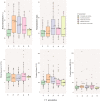Clinical features and follow-up of pediatric patients hospitalized for COVID-19
- PMID: 33852775
- PMCID: PMC8250880
- DOI: 10.1002/ppul.25407
Clinical features and follow-up of pediatric patients hospitalized for COVID-19
Abstract
Objective: This report summarizes the clinical features and 1-month follow-up observations for pediatric patients who were hospitalized with coronavirus disease 2019 (COVID-19) in Wuhan Women and Children's Hospital.
Methods: The 1-month follow-up data included clinical manifestations and results from serum severe acute respiratory syndrome coronavirus 2 (SARS-CoV-2) IgG and IgM tests, reverse-transcription polymerase chain reaction (RT-PCR) for SARS-CoV-2, lung computed tomography (CT) scans, and laboratory tests.
Results: Between January 20 and March 15, 2020, 127 patients aged 0-15 years were hospitalized for COVID-19 treatment, including 3 severe cases and 124 mild or moderate cases. The main therapies included inhalation of aerosolized interferon-α (122/127) and additional antiviral drugs (28/127). Among the 81 patients who had pneumonia at admission, 35 with right lobe pneumonia had the longest hospital stay (mean 14.5 ± 7 days); 17 with left lobe pneumonia had the highest creatine kinase (154 ± 106 U/L) and creatine kinase myocardial band (CK-MB, 43 ± 48 U/L) levels; and 29 with bilateral pneumonia had the highest white blood cell counts (8.3 ± 4 × 109 /L). Among the 46 patients who were successfully followed up 1 month after discharge, two notable findings were right lobe pneumonia in 22% (95% confidence interval [CI]: 11%-37%) of patients and persistently elevated serum creatine kinase and CK-MB levels. The median duration of elevated CK-MB was 45 days. The mean concentrations of serum SARS-CoV-2 IgG and IgM in 41 patients were 8.0 ± 7.5 and 98 ± 40 ng/ml, respectively. At follow-up, four patients retested positive for SARS-CoV-2.
Conclusions: The involvement of different lung lobes in patients with COVID-19 was associated with variations in the persistence of pneumonia and elevation of CK-MB levels and body temperature.
Keywords: coronavirus disease 2019 (COVID-19); follow-up; pediatric patients; severe acute respiratory syndrome coronavirus 2 (SARS-CoV-2).
© 2021 Wiley Periodicals LLC.
Conflict of interest statement
The authors declare that there are no conflict of interests.
Figures



Similar articles
-
Clinical and Immune Features of Hospitalized Pediatric Patients With Coronavirus Disease 2019 (COVID-19) in Wuhan, China.JAMA Netw Open. 2020 Jun 1;3(6):e2010895. doi: 10.1001/jamanetworkopen.2020.10895. JAMA Netw Open. 2020. PMID: 32492165 Free PMC article.
-
COVID-19 IgG/IgM patterns, early IL-6 elevation and long-term radiological sequelae in 75 patients hospitalized due to interstitial pneumonia followed up from 3 to 12 months.PLoS One. 2022 Feb 22;17(2):e0262911. doi: 10.1371/journal.pone.0262911. eCollection 2022. PLoS One. 2022. PMID: 35192635 Free PMC article.
-
Safety and Efficacy of Imatinib for Hospitalized Adults with COVID-19: A structured summary of a study protocol for a randomised controlled trial.Trials. 2020 Oct 28;21(1):897. doi: 10.1186/s13063-020-04819-9. Trials. 2020. PMID: 33115543 Free PMC article.
-
COVID-19 in Children: Clinical Approach and Management.Indian J Pediatr. 2020 Jun;87(6):433-442. doi: 10.1007/s12098-020-03292-1. Epub 2020 Apr 27. Indian J Pediatr. 2020. PMID: 32338347 Free PMC article. Review.
-
Pathophysiology, Transmission, Diagnosis, and Treatment of Coronavirus Disease 2019 (COVID-19): A Review.JAMA. 2020 Aug 25;324(8):782-793. doi: 10.1001/jama.2020.12839. JAMA. 2020. PMID: 32648899 Review.
Cited by
-
Current utilization of interferon alpha for the treatment of coronavirus disease 2019: A comprehensive review.Cytokine Growth Factor Rev. 2022 Feb;63:34-43. doi: 10.1016/j.cytogfr.2022.01.001. Epub 2022 Jan 13. Cytokine Growth Factor Rev. 2022. PMID: 35115233 Free PMC article. Review.
-
Epidemiology and clinical features of SARS-CoV-2 infection in children and adolescents in the pre-Omicron era: A global systematic review and meta-analysis.J Glob Health. 2024 Mar 1;14:05003. doi: 10.7189/jogh.14.05003. J Glob Health. 2024. PMID: 38419461 Free PMC article.
-
Clinical and Laboratory Profile, Management and Outcome of Pediatric SARS-CoV-2 Infection Admitted at the Philippine General Hospital.Acta Med Philipp. 2024 Apr 30;58(7):14-26. doi: 10.47895/amp.v58i7.7717. eCollection 2024. Acta Med Philipp. 2024. PMID: 38882922 Free PMC article.
-
Clinical and Laboratory Characteristics of Pediatric COVID-19 Population-A Bibliometric Analysis.J Clin Med. 2022 Oct 11;11(20):5987. doi: 10.3390/jcm11205987. J Clin Med. 2022. PMID: 36294306 Free PMC article. Review.
References
-
- WHO. COVID‐19 weekly epidemiological update. https://www.who.int/docs/default-source/coronaviruse/situation-reports/2.... Accessed March 16, 2021.
-
- Novel Coronavirus Pneumonia Emergency Response Epidemiology Team . The epidemiological characteristics of an outbreak of 2019 novel coronavirus diseases (COVID‐19) in China. Zhonghua Liu Xing Bing Xue Za Zhi. 2020;41(2):145‐151.
Publication types
MeSH terms
Substances
Grants and funding
LinkOut - more resources
Full Text Sources
Other Literature Sources
Medical
Research Materials
Miscellaneous

